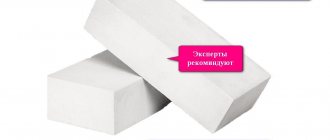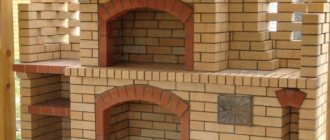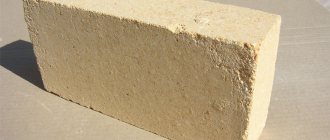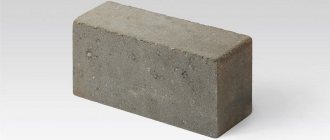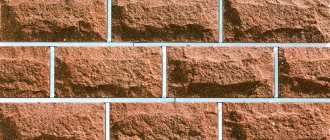How much does sand-lime brick weigh?
Since no construction site can do without bricks, it is worth knowing as much as possible about this material. Bricks are varied in their composition. Among the common options is white sand-lime brick.
Features of the material
This type of brick
icha is the second in demand and popularity in modern construction (the first is ceramic). It looks like an artificial stone of the correct shape.
The positive aspects of the material under consideration include:
- Environmentally friendly.
- Low cost.
- Insulates sound and noise well.
- Resistant to temperature changes.
- Moisture resistant.
- Lasting.
- Reliable.
- It lasts a long time.
- Wide scope of use.
Weight is the main parameter
Before starting construction, it is important to determine how much sand-lime brick weighs. This must be done in advance, since it is the weight of the material that affects the future strength of the foundation of the building and its walls.
However, it is worth remembering that this type of brick is not used for laying foundations, because it begins to quickly absorb water.
The weight of ordinary one-and-a-half silicate material is 4.9 kg. The weight of a single brick is 3.5 kg. The second option has less weight due to the fact that it has emptiness inside. There is also a thickened type of sand-lime brick, measuring 250x120x80. It is hollow and weighs 4 kg. A similar, single version has a mass of 3.2 kg.
Types of bricks
Silicate materials are most often used to construct walls, interior partitions and main building structures.
To make white silicate brick, lime and sand are used. And for processing, water steam is used, which operates under high pressure. The use of standard firing is not applicable here. Thanks to this approach, the brick is clearly formed.
By size, there are several types of bricks, which differ in their weight:
- Single, has a length of 250 mm, a width of up to 120 mm, and its height is 65 mm.
- One and a half. The dimensions, except for the height, are the same as the previous one. Height – 80 mm.
In order to increase the strength of masonry, many factories began to produce non-standard sizes of sand-lime bricks. For the foundation, the dimensions used are 250x120x138 mm.
It is also worth noting that the weight is affected by what kind of material is inside - solid or hollow. The solid one is first filled with a monolith. And the hollow one has emptiness inside. They are located perpendicular to the wider edge.
Masonry - determination of specific gravity
Having determined the mass of the product and silicate, it is important to begin to find out the specific gravity of the masonry. By this parameter you can determine the quality of the future construction. This weight is the mass of m3 of masonry; the mortar for work (made of cement and sand) is also taken into account in the mass.
solid single brick type is characterized by a mass of 1900 kg, the one-and-a-half version is 1892 kg. The composition of the first version of the product in m3 is 513 pieces, and the second version is 317 bricks.
For hollow bricks per 1 m3, the standard weight is 1640 kg, and for the one-and-a-half version - 1400 kg. The number of these bricks per m3 is the same as for solid material.
Material price
The cost of sand-lime brick is low. It has different indicators, which depend on such factors:
- Material type.
- Brand of manufacture.
- Method of transportation and installation.
- There are not only white, but also colored versions of bricks. The cost will be higher than the regular option.
As you can see, for accurate calculations it is simply necessary to clarify the mass of bricks. It is also worth paying attention to the properties of the material to be sure that it is suitable for your construction.
Main varieties and sizes
The decorative material includes a composition of rock and sand product. The preparation does not involve conventional roasting, but uses a production method called autoclave synthesis.
The essence of autoclave processing is to expose the finished weight to high temperature (170-200 C) water vapor and pressure of up to 12 atmospheres. The principle of synthesis is as follows: a pre-prepared mass of 90% quartz sand, 10% light lime plus additives after semi-dry pressing.
Thus, the shape of the brick is formed, and the weight of one one-and-a-half solid silicate brick or its other types is formed.
During production, weather-resistant, alkaline pigments are added to the composition, which color the material in the desired tone.
Main dimensions of sand-lime brick:
- the single type has a length of 250 millimeters, a width of 120 millimeters and a height of 65 millimeters;
Single
- the one-and-a-half type has almost similar indicators, only the height stands out, its component being 80 millimeters;
One and a half
- double type is 250×120×138 .
Double
In addition to regular and thickened versions, factories produce ceramic and silicate types measuring 250x120x138 millimeters. The height of the material corresponds to the height of two single types.
As an alternative to brick, they began to produce and use lightweight concrete blocks measuring 390×190×188 millimeters. Use cellular or concrete with expanded clay aggregate.
Concrete blocks
Among the types of product are:
- solid bricks:
Full-bodied
- empty inside.
Hollow
The first are filled with a solid block of stone, while the second contains voids placed vertically to the widest edge. Sand-lime brick contains through/non-through voids, made to resemble a cylinder.
The presence of voids helps to reduce the mass of the product, and in addition increases the provision of modern parameters of thermal conditions, helps to reduce the level of noise penetrating into the premises from the outside. The weight and volume of one sand-lime brick exceeds the characteristics of ceramic material.
This is explained by the fact that quartz sand and lime contribute to the weight of the product. The elements that are used in the manufacture of this material are characterized by high hygroscopicity, which also has a great influence on the mass.
In order for the floor to be reliable and strong, it is necessary to putty it. Here's all about the types of floor putty.
Crushed stone is obtained by crushing pumice, brick and other metallurgical waste. Here is the density of different types of crushed stone.
Today it is impossible to carry out finishing work without the use of tile adhesive. By clicking on the link you will get acquainted with its characteristics.
When using sand-and-a-half brick to build the walls of a structure, it is generally accepted to distinguish between the front and ordinary categories of material. The volume of a one-and-a-half element is not related to varieties.
The facing or front version is distinguished by its particularly smooth and very attractive plane of the sides , which have an impeccably smooth appearance, which makes it possible to create a beautiful facade of houses.
Cladding facade
Ordinary ordinary material is used for other purposes. This product is only available in white and is needed for building walls and barriers.
Wall of ordinary white
For such work, the uniformity of the planes is very important. The main thing in construction is that the brick has a strong structure.
The dimensions of the sesquisilicate product are standardized by GOST. The actual dimensions of the product are 250 x 120 x 65 millimeters.
In addition, there are several other modifications that correspond to similar length and width ratios, only one difference is only in thickness - 250x120x88 millimeters.
The layer of the wall or partition is a multiple of the length and width. In the wall, 1 stone has a width of 250 millimeters, and the wall of one-and-a-half material is 380 millimeters (250 millimeters + 120 millimeters + 10 millimeters seam between the bricks).
For more details on the dimensions of sand-lime brick, watch the video:
This product weighs about 4 kg. However, the mass of one product tends to vary, including the types and structure of the product. If we are talking about a hollow material, then due to the inclusion of cavities, it is smaller in size. When using hollow one-and-a-half silicate bricks, the weight is 4 kg.
The weight of silicate one-and-a-half bricks in solid use is 4.9 kg. The mass of each material depends directly on the density and volume.
Of course, the size of a hollow material, due to the existing lack of content, will differ to a lesser extent from the size of a solid one.
It turns out that the weight will vary. The same is with the dimensions of the material - the mass of a double silicate material 250x120x138 will slightly exceed the mass of a one and a half silicate material, since its scale is larger.
During the formation of the plan and construction of the system, it is important to take into account a parameter called specific gravity. In other words, this is the mass of 1 m3 of masonry, taking into account the weight of the mixture. This indicator expresses a powerful effect on the foundation system, and also on the mass of the entire structure.
Silicate weight
Size and weight of solid brick:
- single 3.7 kg;
Single
- one and a half 4.2 kg;
One and a half
- double 5.9 kg.
Double
Size and weight of hollow:
- single 3.2 kg;
Single
- one and a half 3.7 kg;
One and a half
- double 5.4 kg.
Double
Weight of white sand-lime brick
For the average person, bricks are mainly divided by color into white and red. In reality, it’s not a matter of color; bricks are divided into different types according to some of their characteristics. One of the popular building materials is sand-lime brick.
Characteristics of sand-lime brick. Advantages and disadvantages
Oddly enough, a material such as sand-lime brick is not at all a leader among other types in terms of technical characteristics; it has a considerable number of negative qualities. Of course, thanks to the rather low cost and availability of production, it has become very widespread.
At the same time, such bricks are produced using a sand-lime mixture, which leads to some negative aspects of this material.
First of all, sand-lime brick absorbs moisture quite strongly, which in winter causes complications for home owners. Excess moisture in a brick wall leads to freezing. As a result, the room becomes colder and the brick itself undergoes destruction faster. To protect against this, the wall must be protected with plaster or finishing of some other material.
The presence of large weight implies the obligatory construction of a more powerful foundation under the building made of sand-lime brick. Compared to ceramic bricks, silicate bricks are almost twice as heavy.
Sand-lime bricks are more fragile than ceramic bricks and can withstand less impact load, although this does not affect the load-bearing characteristics of the wall, so this drawback can be ignored.
Today, this material is used for the construction of private houses and the construction of indoor partitions during major construction projects.
Types of sand-lime bricks
There are two types of sand-lime brick:
- solid, from which load-bearing walls are laid;
- hollow, having internal cavities all the way through.
The walls are made of hollow material; due to the cavities, it has good sound insulation. The voids in the brick also ensure the integrity of the brick joints: if the mortar hardens in the voids, the bricks cannot be moved between each other.
Sand-lime brick can also be faced or ordinary, it all depends on what it is intended for. The role of the front is not only in the protective function of the constructed walls from mechanical and climatic influences, but also in the unique decorative design of the facade of the building.
For example, a wall lined with embossed facing bricks of a non-standard color will create an interesting illusion as if natural stone was used for decoration; the structure will look very original and exclusive.
The facing brick can have a smooth or rough texture. Its color can be natural, like natural raw materials, or dyed.
Sand-lime brick is made from ordinary sand and puffed lime with various additives. All components are mixed and the mixture is autoclaved. It all ends with obtaining a durable artificial stone.
White sand-lime brick is necessarily controlled by weight parameters. It is identical in size to red and ceramic bricks. The requirements for parameters such as geometry, quality and appearance are also similar. White brick is heavier than red brick.
GOST allows maximum size deviations:
- thickness - should not exceed standard dimensions of more than three millimeters and should not be less than two millimeters;
- width - should not deviate by more than three millimeters; the length allows a deviation of no more than four millimeters.
The laying of white brick is absolutely similar to red. The difference may relate to the solution used.
The mortar for laying white silicate bricks is:
- limestone;
- cement-lime;
- cement;
- cement-clay.
The use of white building bricks in the foundation is unacceptable, since it absorbs water well and therefore can quickly collapse.
One brick on today's market costs from four to eight rubles, depending on the type, brand, and transportation costs.
Weight of white sand-lime brick
The weight of one one-and-a-half-size facing hollow white sand-lime brick varies from 3.7 to 4.2 kilograms. There are three hundred seventy-nine pieces in one cubic meter, which in weight ranges from one thousand four hundred kilograms to one thousand five hundred ninety kilograms.
The pallet contains two hundred or two hundred and eighty pieces, which in weight is equal to from seven hundred forty to one thousand one hundred seventy-five kilograms. The weight of the same double-sized brick is from 5 to 5.8 kilograms.
Advantages and disadvantages of sand-lime brick
The undeniable advantages include the following:
Affordable price. The cost of masonry made from such material will be noticeably lower than the construction of a similar structure from ordinary brick and concrete. This is due to the fact that production technology involves the use of cheap and accessible raw materials.
Environmental Safety. Finished products consist only of natural ingredients; the use of chemically active and toxic substances is not allowed.
Ease of use. When laying, it is allowed to use not only cement-sand mortar, but also polymer-based adhesive compositions.
Precise shape geometry. Regardless of the manufacturer, the brick has a traditional rectangular shape, which simplifies the work process.
High resistance to loads. Thanks to this, the material can be used with equal efficiency in private and multi-storey construction.
Excellent sound insulation. The walls reliably isolate the interior from street noise.
Frost resistance. The material can withstand up to 100 freezing cycles without loss of performance properties.
The obvious disadvantages are:
Weight. Sand-lime brick belongs to the category of heavy materials, and therefore requires a solid foundation.
Moisture dependence. The material absorbs water well, which leads to the destruction of the material.
Silicate brick: what is it?
A traditional building material that is widely used is sand-lime brick, the sizes of which vary and come in several types. It is used both for the construction of buildings and for their cladding.
Manufacturing and properties
The main raw material in brick production is quartz sand, the share of which is 90%. Additional strength and snow-white color are provided by the addition of puffed lime. If it is necessary to obtain colored bricks, coloring pigments that are resistant to alkalis and weathering are added to the basic composition.
The production of sand-lime brick is based on the autoclave synthesis method. During the manufacturing process, products are treated with water vapor having a temperature of about 200 degrees, under increased pressure ranging from 8 to 12 atm.
The result is a brick that has a number of remarkable properties, the main of which include:
- the highest strength, resistance to mechanical damage, resistance to chemical influences and atmospheric influences, making it possible to cladding the facades of buildings;
- frost resistance, which is much higher than that of concrete products;
- the ability to be painted in different colors using special dyes;
- durability, which is based on high strength and weather resistance, guaranteeing a long service life of at least 50 years;
- high environmental performance, consisting of harmlessness and absence of toxic emissions;
- beautiful appearance, the ability to match different design style ideas thanks to the available color shades and smooth or textured surface.
It should be noted that sand-lime brick has low moisture resistance, so it is not used in the manufacture of foundations and structures that are in contact with water. In addition, it has low thermal and heat resistance. Because of this, it is not used for the construction of stoves, the inner surface of stove pipes and chimneys.
Types of sand-lime bricks
There are several varieties that have different parameters and affect the weight of sand-lime brick .
- According to the size of the product, brick can be:
- single, having a size of 65x120x250 mm;
- one-and-a-half, with dimensions 88x120x250 mm;
- double – has a size of 138x120x250 mm.
- In terms of quality and appearance:
- facing brick, with increased quality indicators and a flat, smooth or structured surface, used for cladding;
- ordinary, or construction - used for the construction of buildings and structures.
- According to the internal structure:
- solid, having a solid structure without holes or voids;
- hollow, with a different number of holes.
- By color:
- white;
- color.
When choosing sand-lime brick, important parameters that you should pay attention to are density and strength. It is desirable that bricks with a density of 1300 kg/m3 or higher be used in the construction of load-bearing walls.
Strength is indicated by a brand indicator consisting of the letter “M” and a digital value, the size of which indicates the ultimate compressive strength, measured in kg per cm2. This value is important to use in calculations when it comes to the construction of multi-story buildings.
Frost resistance in the marking is indicated by a designation that includes the letter “F” and a number indicating the guaranteed number of cycles, which can be of different values. Central Russia should use bricks with a number of cycles of 35 or more.
To calculate how much a silicate brick weighs , you should decide on the choice of its variety, since each type has a different size, density, strength and, accordingly, weight.
If you make an approximate calculation, taking into account the size and structure of the product, then:
- the weight of a solid single brick will be about 3.8–4 kg;
- weight of a hollow single – about 3.5 kg;
- weight of a full-bodied one and a half - 4.2–5 kg;
- weight of a hollow one and a half - 3.7–4.2 kg;
- the weight of a hollow double is 5–5.8 kg.
Knowing the price of sand-lime brick and the number of bricks on a pallet, you can easily calculate the final amount, the weight of the entire pallet and the required carrying capacity of the vehicle for its transportation and delivery.
Frequently asked questions about bricks - cost, weight, quantity calculation
Brick is one of the oldest building materials.
Structures made from it are found in the territories of Ancient Rome, Egypt, and Mesopotamia.
Even then, with its help they could lay out complex architectural structures: vaults, arches, aqueducts.
In Russia, baked bricks began to be used in the 15th century. And to this day, brick is one of the most popular materials for civil construction.
How much does a brick cost?
For a future developer, this question is basic. Since it, to no small extent, shapes the cost of future housing construction.
Bricks are supplied in pallets, but their quantity is not constant and depends on the internal policy of the manufacturer.
The price of a brick depends on many components:
- From the country of origin. European brick is the most expensive. The cheapest is Belarusian. Russian-made bricks are in the middle price category. And among them, the most affordable in price is a brick produced in the Moscow region.
- From the seller. Purchasing material directly from the manufacturer is one thing, but from a trading company is another. You will have to pay their extra charge. The markup is sometimes up to 100%!
- Brick size. Double, as a rule, is 30 percent more expensive than single, which clearly reduces the cost of construction.
- From the form. Hollow or solid brick. The hollow one is cheaper.
- On its technical characteristics: density (the weight of the product will depend), frost resistance (how many cycles it is designed for), strength.
- From the distance between the supplier and your construction site.
These are general provisions that apply to all types of bricks.
If we look into the problem in more detail, the following picture emerges:
Ceramic brick (in common parlance - red) is prepared from a mixture of clay with various additives, which, during the annealing process, form a variety of colors of the finished product - from dark brown to light straw. What are the current prices for Russian facing bricks (single)?
Average cost for 1 brick:
- Red brick – from 9.8 rubles. up to 13.5 rub.
- Light brick – from 15.5 rubles. up to 20.00 rub.
- Yellow brick – from 15.5 rubles. up to 21.00 rub.
- Brown brick – from 19.00 rub. up to 24.5 rub.
Sand-lime brick (or as it is also called - white) , is prepared from a mixture of air lime and sand. By adding alkali-resistant and weather-resistant pigments, colored bricks are obtained. It is cheaper than clay bricks.
For example, the cost for 1 brick:
- Facing brown and yellow bricks – from RUB 7.00. up to 10.00 rub.
- Ordinary white brick - on average 4.5 rubles.
- Depending on the originality of the color, its price also increases. A green brick costs somewhere around 13.5 rubles, a blue brick costs 15.00 rubles.
How much does a brick weigh?
Interest in how much a brick weighs is absolutely not idle. The weight of the brick determines the load on the foundation, and hence the issue of increasing the cost of construction work.
Transportation costs are also directly related to its weight. Which brick is heavier, ceramic or silicate?
We will not calculate the difference in grams, but in numbers it comes out as follows:
How much does a brick weigh?
Standard brick weight 3.5 kg
The weight of the brick must be taken into account during its transportation and loading operations. A standard brick measures 250x120x65 mm and weighs 3.5 kg . But this mass depends on many parameters and can differ significantly from the standard one.
Red brick weight
In everyday life, ceramic brick is called red. Its weight depends on its brand, the presence of voids, size and shape.
The weight of a solid (without voids) standard ceramic brick (250x120x65 mm) is 3.4-3.8 kg.
The weight of a hollow (with voids) standard ceramic brick (250x120x65 mm) is 2.5 kg.
It is believed that the weight of a solid red brick 250x120x65 mm is 3.5 kg.
This building material can be used for the construction of stoves and fireplaces, swimming pools, as it is resistant to water and high temperatures.
Since there are not only single bricks, but also one-and-a-half and double bricks, their weight is different. In addition, the weight varies depending on its classification (field of application). How much a red brick weighs can be found in the table .
| Red (ceramic) brick | |||
| Size | Weight of one brick, kg. | Weight of bricks on a pallet, kg. (No. of pieces per pallet) | Cube weight, kg. (Number of pieces per cube) |
| Full-bodied | |||
| single | 3,3 — 3,6 | 660-1440 (200-400) | 1693-1847 (513) |
| one and a half | 4 — 4,3 | 800-860 (200) | 1515-1630 (379) |
| double | 6,6 — 7,2 | 1320-1440 (200) | 1597-1742 (242) |
| Hollow | |||
| single | 2,3 — 2,5 | 810-1110 (352-444) | 1180-1283 (513) |
| one and a half | 3 — 3,3 | 865-1148 (288-348) | 1137-1250 (379) |
| double | 4,6 — 5 | 810-1120 (176-224) | 970-1210 (242) |
| Facing hollow | |||
| single | 1,32 — 1,6 | 634-662 (480) | 675-820 (513) |
| one and a half | 2,7 — 3,2 | 950-1125 (352) | 1023-1630 (379) |
Sand-lime brick weight
Sand-lime brick is often called white because of its color. The weight of sand-lime brick differs from the weight of ceramic brick with the same dimensions. The scope of its application is quite diverse - the construction of load-bearing and internal walls, the construction of fences. Its use in conditions of high humidity and temperature is not recommended.
| White (silicate) brick | |||
| Size | Weight of one brick, kg. | Weight of bricks on a pallet, kg. (No. of pieces per pallet) | Weight of a cube of brick, kg. (Number of pieces per cube) |
| Full-bodied | |||
| single | 3,7 | 740-1410 (200-380) | 1900 (513) |
| one and a half | 4,2 — 5 | 840-1400 (200-280) | 1592-1895 (379) |
| Hollow | |||
| single | 3,2 | 810-1110 (200-380) | 1640 (513) |
| one and a half | 3,7 | 865-1148 (200-280) | 1400 (379) |
| double | 5,4 | 810-1120 (200) | 1305 (242) |
| Facing hollow | |||
| one and a half | 3,7 — 4,2 | 740-1175 (200-280) | 1400-1590 (379) |
| double | 5 — 5,8 | 1000-1160 (200) | 1210-1405 (242) |
In addition, from the table you can find out how many bricks are in a pallet, the weight of the pallet and the weight of a brick cube.
How much does a pallet of bricks weigh?
It is impossible to answer this question unambiguously. According to standards, the weight of a pallet should not exceed 850 kg, but manufacturers often ignore these requirements. Therefore, the weight of a pallet of bricks can be roughly taken as 1000 kg (1 ton) .
A more accurate estimate can be obtained from the tables above.
White sand-lime brick - characteristics
Sand-lime brick began to be produced after the formation of modified principles for the production of artificial materials based on autoclave synthesis. The product is made from quartz sand and air suspensions, and additives are also present. The components are subjected to a semi-dry pressing procedure, as a result of which the product is given the desired shape.
Technical characteristics of sand-lime brick
white sand-lime brick
To fully use a product in construction, you need to know its technical characteristics. You should have information about how much white sand-lime brick weighs, what its structure and dimensions are (length, thickness, width, height). The weight of the product depends on its structure.
There are several types of products:
- single hollow – weight 3.2 kg;
- one and a half – weight 4 kg;
- full-bodied – weight 3.5 kg;
- double - weight 4.5 kg.
The size of the product meets the requirements described in GOST 379-69, according to which it must have a parallelepiped shape, have smooth, even edges, and have sharp edges with right angles.
The immediate size of white sand-lime brick is determined by its type:
- single - 250Х120Х65mm;
- one-and-a-half - 250X120X88mm;
- double - 250X120X138mm.
The product has excellent performance characteristics, which allows it to be used in harsh climates with sudden temperature changes. Facing brick has excellent waterproofing characteristics. This facing material can be used to finish the basement of a building, since this area is in constant contact with groundwater.
Advantages and disadvantages of sand-lime brick
Regardless of what the standard sizes of white sand-lime brick are, this product has a number of advantages:
- environmentally friendly material - the product is made from natural materials;
- sound insulation – allows the product to be used in the construction of internal inter-apartment partitions;
- frost resistance - the product can withstand sudden temperature changes;
- durability - the material lasts at least 50 years.
Despite the optimal size and weight of white sand-lime brick, this product has one drawback, which is low heat resistance, which precludes the possibility of its use in the construction of chimneys.
We recommend these articles:
Features of production and operation of the product
The product is made from natural materials. The process begins with mixing water with lime and sand, after which the resulting composition is formed using the autoclave method, at a temperature of 170 - 200 ° C and an atmospheric pressure of up to 10 atm. The result of this is steaming of the product, and after cooling it gains the required level of strength. Thanks to silicate processing, it is possible to obtain products of the following brands: M-125, M-150, M-200 It is necessary to take into account the characteristics of the product in order to use it only in those conditions that correspond to its technical capabilities. For example, brick has excellent vapor permeability and excellent water absorption. Consequently, despite its resistance to temperature changes, it has a low level of frost resistance, not exceeding 25 changes. It is characteristic that brick can be used simultaneously as a facing and main building material. An undoubted advantage is the low cost of white sand-lime brick, which allows it to be actively used during the construction of various objects.
Pricing for sand-lime bricks
Today on the market the price of white sand-lime brick is as follows:
- single smooth – 8r/piece;
- single full-bodied – 10 rubles/piece;
- one and a half full-bodied (M-150) – 9 rubles/piece;
- one and a half full-bodied (M-200) – 12 rubles/piece;
- single facing – 8r/piece;
- single facing rusticated – 17.5 rubles/piece;
- facing smooth – 13.5 rubles/piece.
Having found out how much white sand-lime brick costs, you can plan construction, creating an estimate sheet and determining the costs of the work. Pricing is formed depending on several factors, for example, product dimensions, texture, color, type. It is important to choose a product, taking into account the entire list of factors, which will allow you to purchase a good quality brick, ideal for the construction of a specific project. Traditionally, the price per piece of white sand-lime brick is based on the cost of the raw materials used for its production. To purchase products at the best price, you need to track the cost of raw materials, and also consider offers from different manufacturers. It is important that the technology is followed during the manufacturing process, since the technical characteristics of the product and its operational properties depend on this.
Brick weight per cube (1 m3)
Brick is usually called a wall material that is obtained by firing different types of raw materials.
For ceramics, these are certain types of clay, and for silicate products, sand, lime and water. Each of the considered types of wall products has its own characteristics, which means their weight per unit volume (in our case, a cubic meter) will not be the same. The weight of each individual brick will depend not only on the raw material composition, this indicator is also influenced by production technology (firing temperature, presence of voids, etc.). It should be noted that each wall material has its own tolerances for individual characteristics, including weight.
Weight of ceramic bricks in 1m 3
First, let's look at ceramic bricks. As we have already said, the raw materials for its production are clay and water. The finished product has high strength characteristics, the ability to retain heat and resistance to external aggressive environments. The weight of one unit of standard size brick ranges from 3.4-3.8 kilograms. To improve the thermal insulation properties, as well as reduce the weight of an individual specimen, manufacturers began to produce porous bricks weighing about 2.5 kilograms.
The density of the material is significantly influenced by its structure, as well as its purpose. For example, an indicator such as specific gravity will be equal for all types of ceramics, because such a characteristic indicates the value of the mass of the material without voids.
Solid ceramic brick
A solid brick for laying walls will have more mass than a porous or hollow counterpart. Now let’s look at the main indicators of the weight of solid ceramic bricks:
- for red single brick 1650-1850 kg/m 3;
- one-and-a-half clay brick has a weight of 1500-1600 kg/m 3;
- double ceramic brick – 1600-1750 kg/m3;
Hollow Ceramic Brick
The weight of a brick with voids will depend on its overall dimensions and the volume fraction of the cracks; it has the following values:
- single ordinary brick - 1200-1280 kg/m 3;
- one-and-a-half clay brick - 1130-1260 kg/m 3;
- the weight of one and a half bricks ranges from 970 to 1200 kg/m 3.
The lightest hollow brick is considered to be a facing hollow brick, which allows reducing the load on the foundation: a single brick weighs 650-820 kg/m3, and a one-and-a-half brick weighs 1000-1620 kg/m3.
Weight of sand-lime brick in 1 m 3
The maximum weight has silicate brick, which is made from quartz sand, lime and water purified from harmful impurities. This material has a good level of sound insulation and a long service life. The products in question are usually used for laying load-bearing walls and finishing facades. A solid brick weighs at least 3.7 kilograms, while a hollow brick weighs only 3.2 kilograms. The mass of ordinary solid materials is as follows:
- single – 1600-1700 kg/m3;
- one and a half - 1400-1500 kg/m 3;
- double – 1300 kg/m3.
If we consider the mass of silicate slotted brick, it is as follows: for single 1400-1500 kg/m 3, for double – 1100-1200 kg/m 3.
The weight of a brick per cubic meter can be calculated independently, knowing the mass of an individual product and the quantity per given volume. For example, in a cubic meter of solid sand-lime brick there are 500 pieces (notional quantity), and the average weight of the product is 4 kilograms. In this case, the density indicator will be 500 × 4 = 2000 kg/m 3.
Weight of single, one and a half and double sand-lime bricks
When erecting a brick structure, in order to comply with all building standards, you need to know some parameters of the material: weight, dimensions and density. And it is the mass of the brick that is most important, since this indicator will help in the future to calculate both the consumption of raw materials and the permissible load on the structure. Sand-lime brick is the heaviest of all its “brothers”. For example, the weight of one and a half silicate bricks 250x120x88 can be 3.7-5 kg. But why such a difference in mass? The thing is that modern manufacturers, when producing materials, are guided by specific specifications, which allow for some discrepancies. Let's figure out how much sand-lime brick weighs, taking into account its size and shape.
Let's weigh the sand-lime brick
Why know the weight of a brick
There are many reasons for this; they begin at the transportation stage. Bricks are often sold in cubic meters. When ordering transportation, it is not known what carrying capacity of the vehicle is required to purchase, for example, 4 m3 of sand-lime brick. Thanks to calculations, this is easy to do.
There is another reason for calculating the weight, it is the need to set the correct foundation capacity.
If the volume and density are insufficient, then soon the house will settle and cracks will appear, and the structure will have to be strengthened.
Thanks to simple calculations, it will be possible to calculate the weight of supporting structures and assume the additional mass of objects inside the room.
